Medinilla: types, care and reproduction at home, diseases
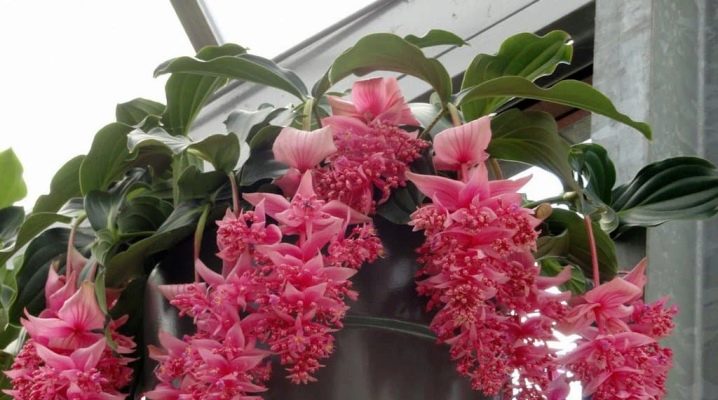
Tropical indoor flowers are unusual plants that were brought to the European part of the globe from distant countries. The long and painstaking work of breeders made it possible to adapt unusual flowers to various climatic conditions. There are a huge number of tropical green pets in specialized stores. One of the most capricious flowers that can please with amazing inflorescences is medinilla.
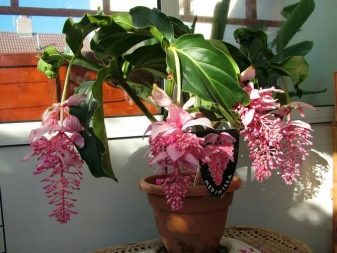

Description
Medinilla is an indoor tropical flower that belongs to the Melastoma family. The plant is native to the Philippine Islands, Australia, India and Africa. Under natural conditions, the height of the plant can reach about 2 meters.
The capricious flower has dark, ribbed stems with few scales, as well as large and dense leaf plates that grow several pieces from one node.
A characteristic feature of the leaves is the presence of a central light vein and several longitudinal veins.

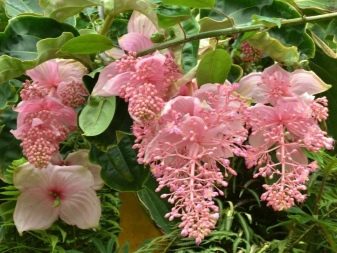
The inflorescences that form in late spring are the most attractive. Flowers in the form of bunches of grapes are formed in the axils of the upper shoots. Long pedicels descend below the central trunk. Multicolored brushes consist of corollas in the form of bells or small tubes, near which delicate bracts are formed. The color of the flowers can be either pink or purple. Long stamens with beautiful anthers are located inside the pith.
After the flower stalks wilt, berries are formed in their place in the form of elongated pears, inside which there are a large number of small seeds. The seed of medinilla is covered with brown skin and has a triangular shape. The branched root system of a plant consists of adventitious roots that do not have a central root.
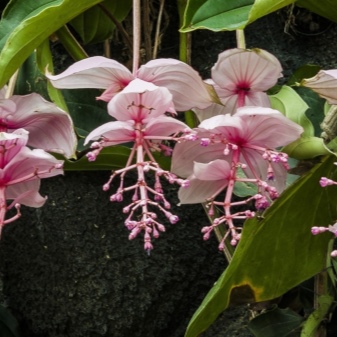
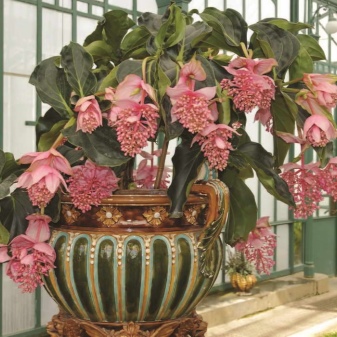
Types and varieties
This tropical plant in natural nature has more than 350 varieties. Not all species have adapted in the European climatic zone. Domestic breeders identify several of the most popular types of medinilla.
Magnificent (magnifica, beautiful)
An evergreen shrub, the height of which in nature can exceed 150 cm. The homeland of this variety is the Philippine Islands and the territory of Indonesia.
The size of the dark green leaf plate exceeds 25 cm. Straight and fleshy branches grow from scaly internodes. The maximum length of one inflorescence can be 30 cm. The bracts around the small bells are pale pink in color. The plant prefers a climate similar to a tropical one.
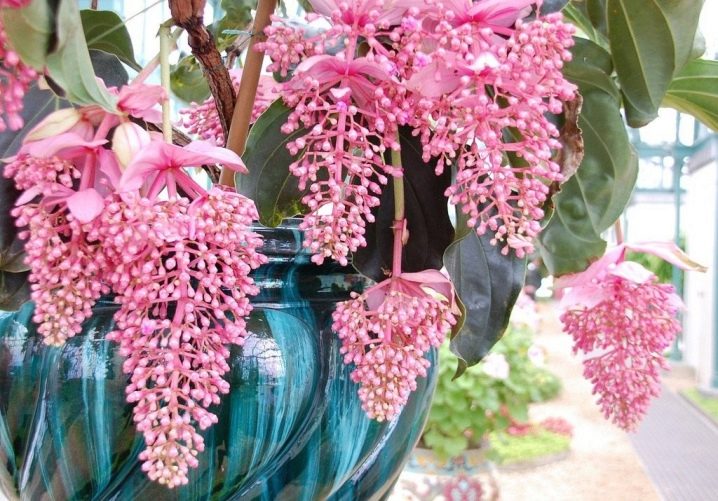
This species has several popular varieties.
- "Dolce Vita" - a plant with bright pink inflorescences, around which you can see several thin bracts.
- "Trizor" - an unusual variety that lacks bracts, and inflorescences with cone-shaped petals have a blue tint.
- "White" - a beautiful variety, has red inflorescences and short petioles.
- "Flamenco" - highly decorative variety, forms rich pink inflorescences. The maximum flower height in natural nature reaches 50 cm, and the size of one brush is 30 cm.

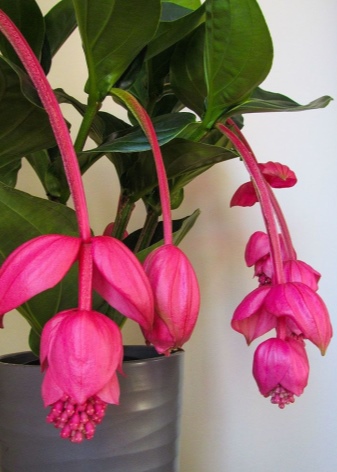
Veined
Partially epiphytic species, which has a thin shoot in the form of tubes covered with scales. The shape of the green leaves is oval with sharp edges, the maximum length is 25 cm. There are 7 veins on the upper side of the leaf plate. The color of the tubular flowers is white.
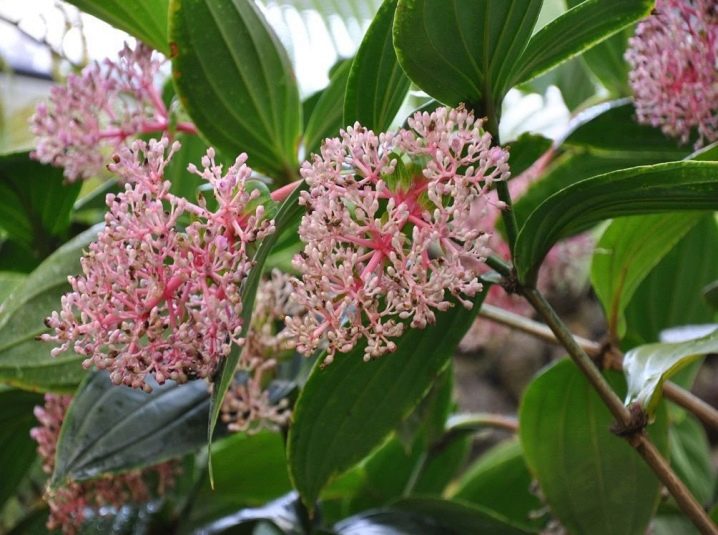
Cuming
Low appearance, characterized by ovoid leaves with a sunken surface. The length of the leaf plate is 30 cm.The size of the pink corolla is about 6 cm.
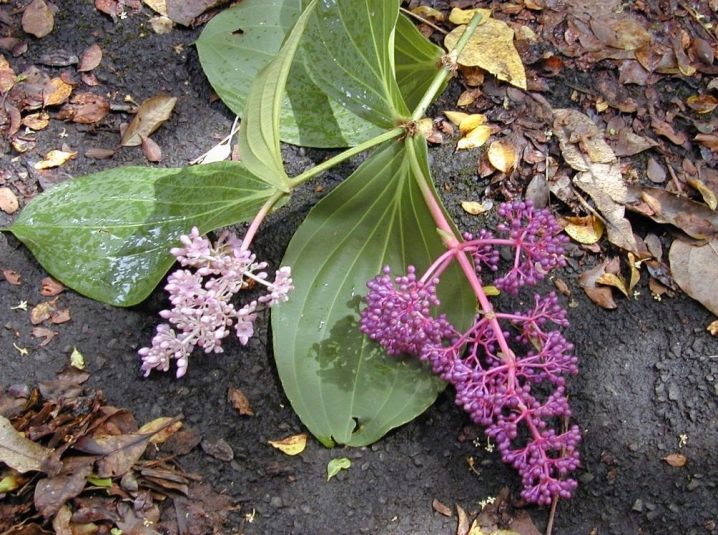
Javanika
An unpretentious view that feels comfortable in the European climatic zone. The leaf plate is green and oval in shape. A characteristic feature is the absence of bracts and the presence of deep purple flowers.
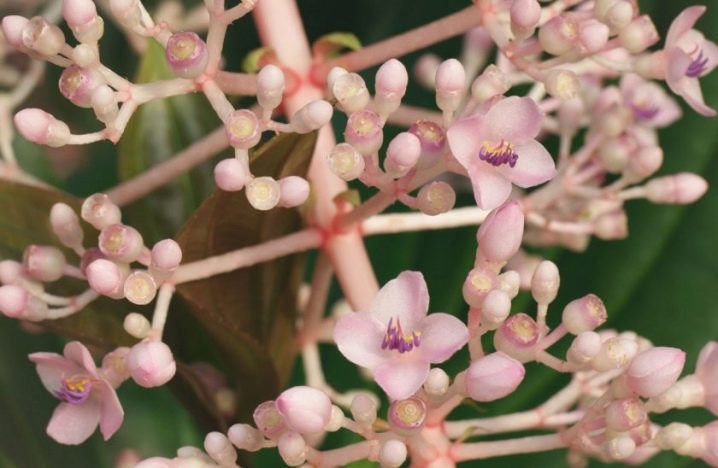
For home cultivation, biologists recommend paying attention to medinilla sedum. This species is intended for cultivation in terrariums and florariums. The plant is small in size, and the maximum length of the stems does not exceed 17 cm. The leaf blade is smooth and leathery. In each sinus, pink flowers are formed with a length of no more than 15 mm. A characteristic feature is the absence of bracts.
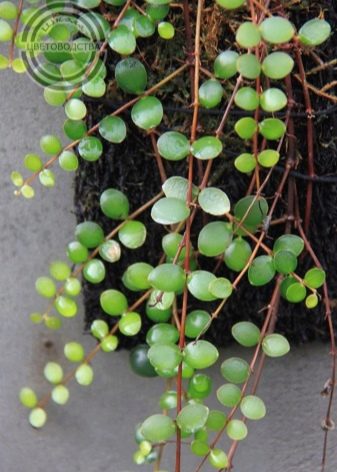

Home care
A beautiful but finicky plant needs special attention. For a flower to grow and develop, it is necessary to create a comfortable temperature regime and a favorable level of humidity.
Lighting
Medinilla prefers rooms with good lighting. Experienced flower growers recommend placing flower pots on windowsills with windows facing west or east.
In autumn and winter, artificial light sources must be used.
In the summer, it is strictly forbidden to place a houseplant in direct sunlight, the ultraviolet radiation of which can lead to the development of diseases, and sometimes even to the death of a pet.
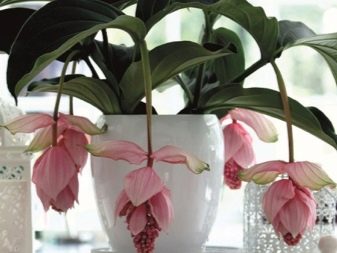

Temperature and humidity
The most comfortable temperature level in summer is + 25 degrees. In winter, the air temperature should not be lower than +18 degrees. A change in temperature and its sharp fluctuations can provoke the death of a tropical flower.
The plant needs a high level of moisture. To maintain it in the summer, it is necessary to regularly spray the leaf plates, and also place vases with water near the pot. Particular attention should be paid to a green pet in winter, when the heating system is working and the level of humidity in the room is significantly reduced. If the plant loses its attractiveness and sheds its leaves, the indoor humidity should be increased.
The flower responds positively to regular wiping of the leaf plate with a damp sponge, as well as to periodic washing of foliage and stems with a shower.
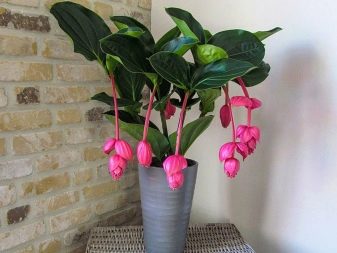

Watering and feeding
During the formation of buds, the flower needs constant moistening of the soil. During flowering, the intensity of watering must be reduced, and during the dormant period, the soil can be moistened only after the soil has completely dried out. For irrigation, it is necessary to use settled water at room temperature, which contains a minimum amount of salts of heavy metals, chlorine and lime.
Mineral fertilizers can be applied from spring to mid-autumn.
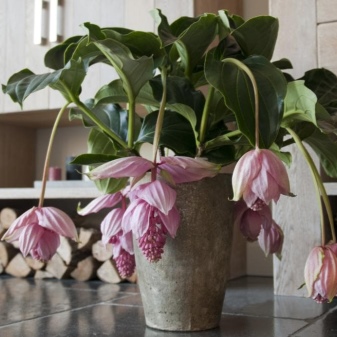
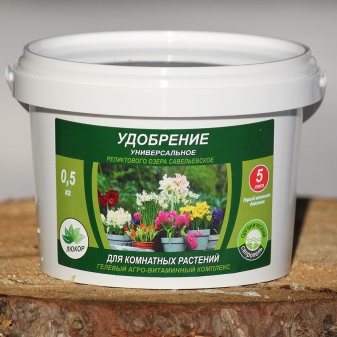
Transplant and pruning
Breeders recommend transplanting an adult plant no more than once every three years. This procedure must be carried out in early spring, when the plant has not yet begun to form buds.
For planting, it is necessary to acquire loose and light soil, which is enriched with a large amount of nutrients. When making your own soil mixture, you should combine sod and deciduous soil with peat, humus and sand in equal proportions.
To increase breathability, experienced gardeners recommend adding a small amount of chopped bark to the mixture.
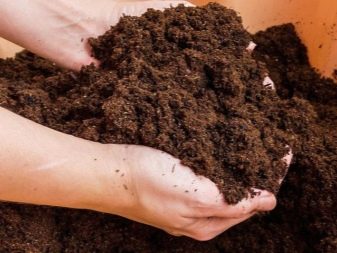
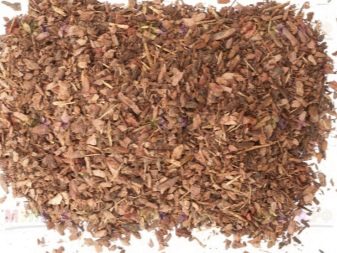
Before rooting a flower in a new pot, it is imperative to clear the roots of the old soil and remove dry and damaged roots. A prerequisite for planting is the presence of a thick drainage layer, which will prevent the development of root rot.
The tropical plant responds positively to sanitary and formative pruning. These manipulations can be carried out after the end of the flowering period. Removing the top of the stems will stimulate the growth of lateral shoots and lead to a significant increase in green mass.
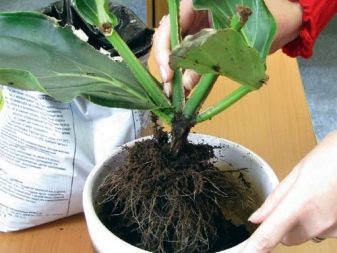
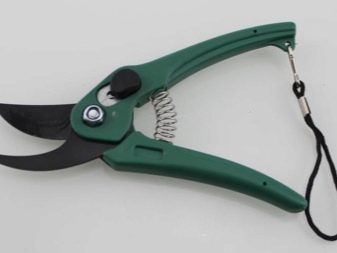
Inexperienced gardeners when growing medinilla can face a number of difficulties that will provoke the following problems:
- low moisture level - reduction and twisting of the sheet plate;
- frequent changes in location and drafts - falling flowers and green mass;
- insufficient illumination - the formation of a small number of colors or their complete absence;
- direct sunlight - the formation of light spots;
- abundant soil moisture and stagnant water - the appearance of root rot and leaf blight.
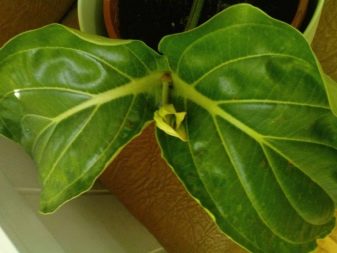
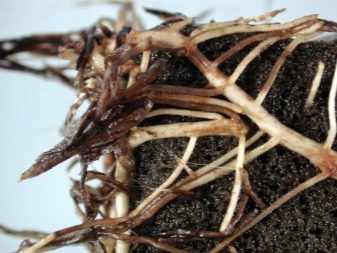
Reproduction methods
Medinilla is a very capricious flower that does not lend itself well to reproduction, so it will be difficult for inexperienced growers to grow a new plant on their own. Breeders distinguish two ways to reproduce a flower:
- cuttings;
- seeds.
To obtain a young plant by rooting cuttings, it is necessary at the beginning of winter or in spring to cut off small shoots from the mother bush, which should have at least two nodes, and put them in a container with water or in a technical container with wet peat. Due to the low percentage of rootlets, experts recommend adding a root growth stimulator to the water. After the roots appear, it is necessary to root the processes and be sure to pinch the upper part. This manipulation will stimulate the growth of lateral shoots.
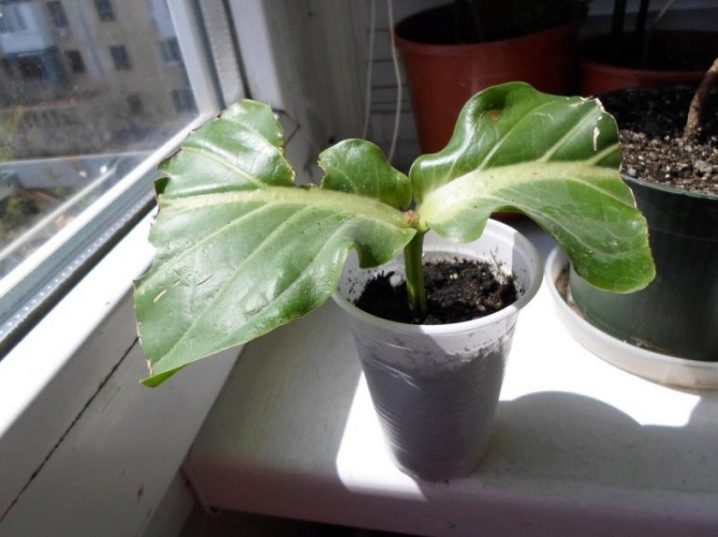
If you have fresh seed, you can try to grow a young plant from seed at home. Planting fresh seeds in late winter or early spring in a small container filled with turf and sand. Seed material is spread on the soil surface and abundantly moistened with a spray bottle. To increase the germination percentage, cover the container with plastic wrap and place the pot in a well-lit and warm place. Only after the appearance of 3 new sheet plates can a pick be carried out.

Diseases
Before buying a plant, novice gardeners need to take into account the high level of soreness of medinilla. Among the most dangerous pests, botanists distinguish the following insects:
- mealybug;
- spider mite;
- aphid;
- shield.
The presence of white bloom on the leaf plate, as well as the gradual wilting of the flower, indicates the appearance of a mealybug. In order to cure a plant, it is necessary to treat it with special chemicals.
If yellow spots and thin cobweb threads are found, which indicate the presence of a spider mite, wash all the leaves with soapy water and then wipe them with medical alcohol. If this manipulation does not bring the desired result, it is necessary to apply insecticides.

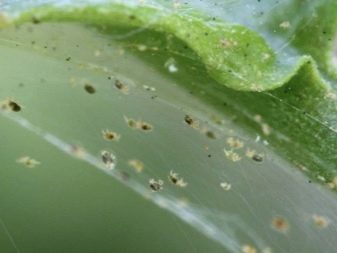
Aphids are one of the most dangerous pests that form colonies on the underside of the leaf blade. The insect leads to curling of the leaves, the appearance of a sticky bloom, and subsequently to the wilting of the flower. To solve this problem, it is necessary to treat medinilla with drugs in which the main active ingredient is permethrin.
The most noticeable pest that can be found during the visual inspection of the plant is the scale insect. You can get rid of this insect only with the help of special chemicals.
Among the most dangerous diseases, biologists note gray botrytis, which, when a plant is damaged, provokes the appearance of dark spots. Before processing a flower with preparations with a foundation, it is necessary to cut off and discard all affected areas.
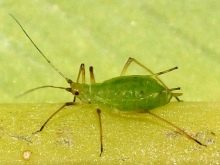
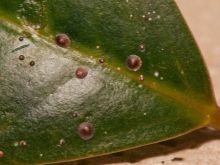
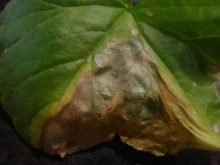
Medinilla is one of the most capricious tropical plants, the cultivation of which will require a lot of knowledge, effort and time. Many novice gardeners do not pay enough attention to medinilla and are disappointed in the long absence of flowers.
Only a healthy and strong plant, for which the most comfortable conditions have been created, will be able to please its owners with bright and massive flowering.

For media care, see the next video.























The comment was sent successfully.